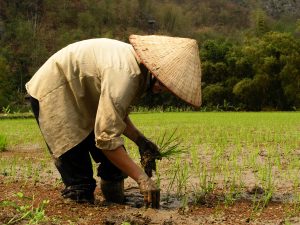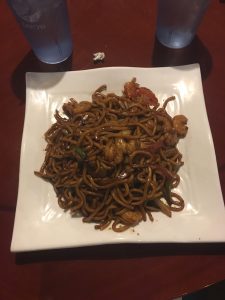By: Audrey Rotman, Betsy Morris, Katie Lee Crockett, and Alex Darras
Chin Chin, we are not in China anymore…
Although we dined at an “authentic” Chinese restaurant called Chin Chin, the food in China is prepared very differently. At Chin Chin, along with research, we discovered the Americanization of Chinese foods, especially of the two common staples, rice and noodles. Regional differences have created variation within meal preparation and typical cuisine. By eating our own “authentic” Chinese dishes, we were able to debunk the stereotypes of a true Chinese meal.
History of Rice

Rice historically stands as a native dish to southern China. The rice bowl, a metaphor for food, symbolizes well-being in general, and remains the most important cereal grain (Leppman 30). The Chinese make the rice in southern China short-grained and sticky and thus allowing easy use of chopsticks with the meal (Leppman 32). Rice continues to be a staple in the Chinese diet. Therefore, the Chinese keep a secure supply of this grain for the survival of all, rich and poor. 75% of China’s population are farmers (China: Food for a Billion Plus). The farmers play a major role in the production of rice, and if they suddenly couldn’t provide rice for the Chinese population, then people would go hungry. People serve rice at almost every meal because it brings not only Chinese people but also foreigners together.
History of Noodles

Noodles typically form a part of northern China cuisine. Corn and wheat “dominate grain farming in northern China today” (Leppman pg. 33). China’s climate didn’t originally suit the growth of wheat, but during the Han dynasty, the development of the the production of noodles helped introduce wheat into Chinese agriculture (Leppman pg. 33). During the Song dynasty (960 – 1279), “noodles made from wheat became a common staple for both the rich and poor” (Leppman pg. 34). Therefore, noodles quickly developed into a popular dish due to the appealing taste and economic benefits. Rice and noodles both grew in popularity over the years, but notable regional differences ensued early on because of natural factors like the climate (Leppman pg 33). Such “regionalization of China into rice in the south and other grains in the north [were] in place by the Han dynasty (207 B.C. to A.D. 200); that same pattern endures today” (Leppman pg. 31).
